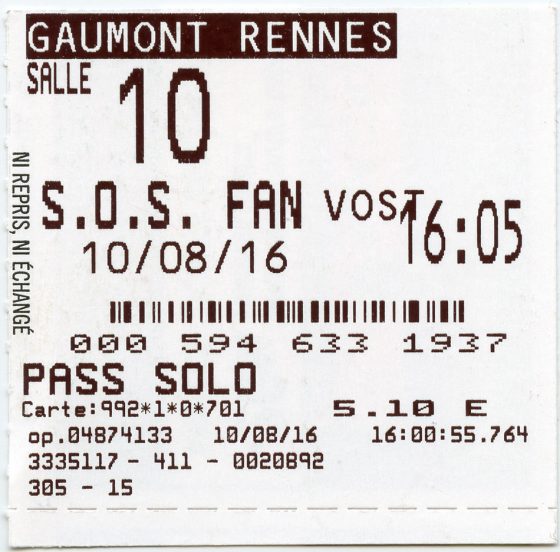Ghostbusters 2016

Letter to a Future Action Figure
My friend Bob has a low tolerance for lousy films, and an even lower ones for lifeless ones. Ghostbusters 2016 is certainly in the second category. Its best characteristic was its being retitled S.O.S. Fântomes in French. Bored soulless, I spent the last half of the film composing the following challenge to him, which I then sent via email:
1) Buy a ticket to the new Ghostbusters.
2) Sit down in the theater.
3) When the movie starts, start the video camera, pointed at your face. This is to confirm you are watching the movie, and not rending the eyes from your skull.
4) For every minute you watch, I will pay you $1.
5) I’ll bet you $100 you won’t make $10.
I spent a lot of time on the amount I was going to pay Bob per minute, until I came upon the bet at the end. Pretty smart, I thought to myself, until I realized what I had paid to watch it myself.

Let’s be clear. This is not an open offer to all. You have acclimated to the New Bland, and may have even seen the film. Maybe you had a ‘good’ time, meaning the A/C was decent. No objection here. Me, I was desperate to find something funny in the humor vacuum contained therein, and I clung to it.
There’s a reason that this imaginary bet struck me funny (it’s been nine days now, and Bob has not taken me up on it). In this story Bob, though a ‘person’ in ‘real’ life, is also a character in a story. A character that could not win $110 challenge and a $100 sideline by sitting still for a while is funny-ish, as I imagined him crying ‘this will not stand’ ten minutes in, hurling the camera to the ground, accidentally uploading the film to the cloud, and landing himself in jail for pirating…Ghostbusters.
The middling level incompetence somehow captures the film: neither Ed Wood, nor Ed Wood enough.
Why did my subconscious send me this gag? Because of the film’s failure to grasp basic characters. Big comedy (and probably all character comedy, and probably all films) requires that the characters be types. This is not a bad thing. Getting back to the Bobperson/Bobcharacter split, and praying that he never reads this, we don’t identify with characters because they are like us, but because they are like the shards that make us up. Which is only fair since we make up the shards.
On one hand, we’re all Mr. Jimmy Stewart in It’s a Wonderful Life, all underappreciated sacrifice. On the other, we’re Bad Santa, saying and drinking whatever we want. With the Hans Gruberes’ and George Michaelses and Wall•Eeee’s, films are just conversations in our head, because our head is all we got. If the character is more than one thing, there is a misidentification, because we can’t be two things at once.
Fine, this theory involves a new conception of psychology and probably isn’t true. But think about jokes. For a joke to work, you pose two contradictory truths next to each other. For a character joke to work, we must know how the character is going to react. With typeage, we do know. We will briefly consider one of the classic joke piles of all time.
Early on in Arrested Development, Michael Bluth opens the freezer to discover a bag that reads ‘Dead dove. Do not eat.’ This is automatic admission to joke Valhalla, but to Valhalla’s Valhalla when in the back of our heads there is a character (Gob) who would believably write that. As you no doubt know and then pretend that I’m not telling someone else’s joke (I’m ruining someone else’s joke, if you must know), Michael proceeds to open the bag and say ‘I don’t know what I was expecting.’ This would work for anyone, but even more for the family’s straight man. It’s a moderately astonishing five seconds, but operates exponentially via our knowledge of the characters.

Minus the ‘ones’ seems even more apropos. Also, there’s something especially perverse about making this your stopover film from the idyllic beach expanses of Île de Ré and home. I saved €6 gas money! Which I later blew on Jason Bourne.
Ghostbusters 2016, no such luck. The best defined character is, unfortunately for our female led cast, is Mr. Chris Hemsworth’s pretty dummy. Mr. Hemsworth does not change, and does not acquit himself poorly.
Taking Ms. Kristen Wiig as an example, she is an uptight scientist who is also a naive believer in ghosts. Ms. Kate McKinnon is the gadget maker, but also the badass, and so on. Oddly, Ms. McKinnon also acquits herself well, even with no character to actually to play.
The lack of necessary cliché means the characters can only float around the sometimes achingly lame physical gags. Being two different characters at once means that they can have any reaction, and so as an audience, even the simple ‘I can’t believe that character is in that situation’ dynamics are gone.
The fact that the jokes have no business existing does not aid the matter. My favorite sequence? Character (which one? Who knows?) says ‘no problem with ghost gun’, cut to same character riding out of control ghost gun. Pretty unmemorable ‘you’ll never see me committing mass genocide’ comedy juxtaposition.
The scene jumps out, however, when the filmmakers tacked on a slam cut to Ms. Leslie Jones laughing, the expectation that we would be laughing with her. When you see it in the quiet of a fish-dead audience, it was quite funny.
If you imagine Bob watching it.
The Take

-$2.00
 [logo]
[logo]